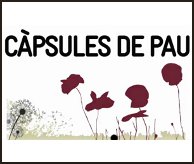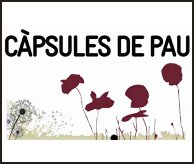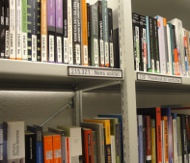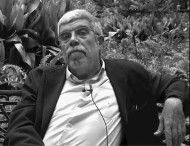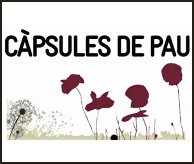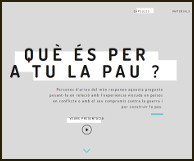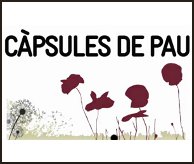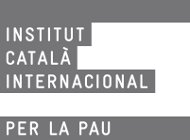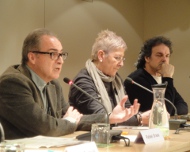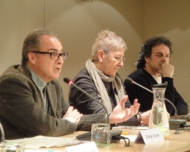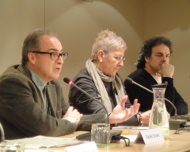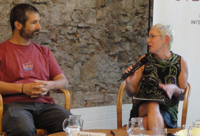A new video of the project ‘Peace Capsules’ , coproduced by ICIP and Col·lectiu Contrast, has been published this week on the ICIP website. It is a short one minute long video entitled ‘What is Peace to Maixabel Lasa?’ and in which Lasa, victim of ETA, considers what peace means to her. The video is accessible both on the ICIP website and on the ICIP Youtube Channel .
Until the 21st September 2014, International Day of Peace, ICIP will publish a new video capsule each week. Each capsule will count with the participation of an activist, actor or academic who will think of what peace means to him/her. The aim of the project is to compile different approximations to the concept ‘peace’ on the ICIP website.
Author: whads
What is Peace to Maixabel Lasa?
A new video of the project ‘Peace Capsules’ , coproduced by ICIP and Col·lectiu Contrast, has been published this week on the ICIP website. It is a short one minute long video entitled ‘What is Peace to Maixabel Lasa?’ and in which Lasa, victim of ETA, considers what peace means to her. The video is accessible both on the ICIP website and on the ICIP Youtube Channel .
Until the 21st September 2014, International Day of Peace, ICIP will publish a new video capsule each week. Each capsule will count with the participation of an activist, actor or academic who will think of what peace means to him/her. The aim of the project is to compile different approximations to the concept ‘peace’ on the ICIP website.
Last month acquisitions of ICIP Library
ICIP’s library is located at Gran Via de les Corts Catalanes 658, Barcelona. It is opened from 9 a.m. to 7 p.m. Monday to Friday and it is designed to be a center specialized in the topics of Peace, Human Security and Conflict. The purpose of the library is to facilitate and allow access to the literature belonging to these fields and to make research materials available to the public. It is a reference center that is one of a kind within Catalonia.
The library serves as a base for the International Catalan Institute for Peace, with the literature it contains being essential to both researchers and experts in the Peace Research field. The center forms part of a network of specialized libraries sponsored by the Generalitat of Catalonia and it is in constant contact with institutions and research centers with similar objectives located around the world.
“Remembering Alfons Banda”
ICIP and FundiPau have released the video “Remembering Alfons Banda”, in which various people from the peace movement, friends and relatives pay tribute to Alfons, his disposition and his commitment to and work for peace.
The video, produced by the association Fora de Quadre, was screened at the event in memory of Alfons that took place in the Auditorium of the University of Barcelona on September 29.
Participants include Jordi Armadans, Pepe Beunza, Tica Font, Rafael Grasa, Xavier Masllorens, Federico Mayor Zaragoza and Arcadi Oliveres.
What is Peace to Pilar Massana?
A new video of the project ‘Peace Capsules’ , coproduced by ICIP and Col·lectiu Contrast, has been published this week on the ICIP website. It is a short one minute long video entitled “What is peace to Pilar Massana? “, and in which Massana, spokesperson of the platform Aturem la guerra, considers what peace means to her. The video is accessible both on the ICIP website and on the ICIP Youtube Channel .
Until the 21st September 2014, International Day of Peace, ICIP will publish a new video capsule each week. Each capsule will count with the participation of an activist, actor or academic who will think of what peace means to him/her. The aim of the project is to compile different approximations to the concept ‘peace’ on the ICIP web site.
Peace Capsules Project launches new website
The Peace Capsules Project aims to show the diversity of visions and expectations projected on the word “peace”. It is a co-production of the International Catalan Institute for Peace (ICIP) and the Contrast Collective, with the collaboration of Digital Dosis.
Fifty-two people from around the world answer the question: What is peace to you? in connection with their experience in countries in conflict or with their commitment against war and in favor of the building of peace.
Each one of these reflections, produced in video format with subtitles in Catalan, Spanish and English, are called capsules and are compiled on the website www.capsulesdepau.com. The different capsules are organized by name, date and country of origin.
People participating in the project who explain their vision of peace include:
Peace researchers, such as John Paul Lederach (Professor at the Joan B. Kroc Institute for International Peace Studies, University of Notre Dame), Jenny Pearce (Director of the International Centre for Participation Studies in the Department of Peace Studies, University of Bradford) and Christopher Kayumba (Editor of the Rwandan daily The Chronicles)
Peace activists, such as Pepe Beunza (first conscientious objector for ideological reasons in Spain), Marina Gallego (member of the Ruta Pacífica de las Mujeres de Colombia), and Yolanda Aguilar (founder of the organization Actoras de Cambio of Guatemala)
People who have experienced conflict firsthand, such as Nadia Ghulam (a victim of the war in Afghanistan), Mohlamin M. Brahim (a refugee in the Sahrawi refugee camps in Algeria), Ali Abou (a Lebanese ex-prisoner) or Neus Català (a survivor of the Ravensbrück concentration camp)
The diversity of both the roles of the protagonists and their origin (Afghanistan, Bosnia, Colombia, Guatemala, Iraq, Lebanon, Rwanda, Western Sahara, and Tibet, among others) allows for the construction of a global vision of peace. Peace as a synonym of social justice, equal opportunities, the absence of direct and indirect violence, the struggle for the recognition of human rights, but also peace understood as harmony, as inner peace.
Teaching materials
As a complement to the capsules, the website also contains different educational proposals which aim to promote personal competencies that facilitate the analysis of violences and opportunities for peace, as well as the practice of creative conflict transformation. At the same time, these proposals seek a commitment to the promotion of a positive peace. These teaching materials are aimed at both the formal and informal fields of education in order to facilitate a more integral approach leading to the incorporation of peace culture in the education project.
What is Peace to Ahmad Atawneh?
A new video of the project ‘Peace Capsules’, coproduced by ICIP and Col•lectiu Contrast, has been published this week on the ICIP website. It is a short one minute long video entitled ‘What is Peace to Ahmad Atawneh?’ and in which Atawneh, member of the Palestinian Community in Catalonia, considers what peace means to him. The video is accessible both on the ICIP website and on the ICIP Youtube Channel .
Until the 21st September 2014, International Day of Peace, ICIP will publish a new video capsule each week. Each capsule will count with the participation of an activist, actor or academic who will think of what peace means to him/her. The aim of the project is to compile different approximations to the concept ‘peace’ on the ICIP web site.
Nova Notícia
??? default.cos ???
A good exercise in forgiveness and reconciliation
The presentation of the book Los ojos del otro. Encuentros restaurativos entre víctimas y ex miembros de ETA took place at the Palau Robert on Wednesday, February 19.
The book describes the meetings that took place in 2011 and 2012 between people who had experienced the direct violence of ETA (either directly as victims or as relatives) and people who had perpetrated acts of violence and are serving time in prison.
Over a hundred people attended the event, organized by ICIP. Among the participants were Maixabel Lasa, ETA victim and one of the participants in the restorative meetings described in the book; Eduardo Santos, mediator in the meetings; Esther Pascual, book and mediation team coordinator; Txema Urkijo, advisor to the Victims of Terrorism Office of the Basque Government; and Rafael Grasa, president of ICIP.
The meetings celebrated between victims and ex-members of ETA – prisoners who have distanced themselves from the organization and have condemned violence – originated as a desire of some of the inmates of the Nanclares de Oca (Araba/Álava) prison to approach their victims, as part of their internal process to separate themselves from the use of violence. The positive response to the initiative by the victims, and the good working relationship between the Victims of Terrorism Office of the Basque Government and the Department of Penal Institutions, allowed for the meetings to take place, according to Urkijo. A total of fourteen meetings between victims and perpetrators took place between 2011 and 2012, and they were all successful.
The role of mediator
The meetings, during which participants were able to freely express themselves, lasted between two and four hours, and were meticulously prepared by a mediation team coordinated by Esther Pascual. The mediator’s job is to transmit trust so that the participants can feel at ease, and the limitations are basic, according to mediator Eduardo Santos: “mutual respect, an attitude of dialogue and an encounter that does not produce more harm than the harm caused previously.”
Esther Pascual explained that the restorative meetings “have provided a response to the needs of the victims – a response they didn’t have during the criminal proceedings – to eliminate hatred, to listen to the harm caused and to recognize the value of forgiveness.” And, according to Pascual, “an ethical responsibility and the need to highlight the existence of dialogue and the significance of restorative justice” made it necessary to publish the content of these experiences.
The testimony of Maixabel Lasa
Maixabel Lasa, widow of Juan María Jáuregui (ex- Socialist prefect of Gipuzkoa/Guipúzcoa, assassinated by ETA in 2000) is one of the victims who participated in these meetings. On May 26, 2011, she sat next to Luis María Carrasco, the person who killed her husband, in the Nanclares de Oca prison. She describes the experience of this meeting in the book Los ojos del otro, and she also gave her testimony in the event celebrated in Barcelona on Wednesday.“I went to the meeting because I’ve always defended, and I continue to defend, that everyone has the right to a second chance,” she said. And she added, “I shook his hand. I was calm, but Luis was quite nervous, and ashamed. And the first thing I asked him was if he knew my husband. He made it clear that he received orders and followed them. He had very low self-esteem and kept on saying that everything he had was bad. And I told him that if we were there, he must have something good.”
Maixabel Lasa said that she participated in the meeting with absolute freedom, she left with a feeling of “inner peace,” and she demands respect for having taken this step, aware that some victims of terrorism have declared their opposition to this initiative.
The program of restorative meetings has been at a standstill since the People’s Party took over the Spanish government. According to Txema Urkijo, “there hasn’t been an outright refusal to celebrate the meetings, but the increasing amount of obstacles and difficulties has led the initiative to a dead end, because Penal Institutions does not believe in rehabilitation.”
A good exercise in forgiveness and reconciliation
The presentation of the book Los ojos del otro. Encuentros restaurativos entre víctimas y ex miembros de ETA took place at the Palau Robert on Wednesday, February 19.
The book describes the meetings that took place in 2011 and 2012 between people who had experienced the direct violence of ETA (either directly as victims or as relatives) and people who had perpetrated acts of violence and are serving time in prison.
Over a hundred people attended the event, organized by ICIP. Among the participants were Maixabel Lasa, ETA victim and one of the participants in the restorative meetings described in the book; Eduardo Santos, mediator in the meetings; Esther Pascual, book and mediation team coordinator; Txema Urkijo, advisor to the Victims of Terrorism Office of the Basque Government; and Rafael Grasa, president of ICIP.
The meetings celebrated between victims and ex-members of ETA – prisoners who have distanced themselves from the organization and have condemned violence – originated as a desire of some of the inmates of the Nanclares de Oca (Araba/Álava) prison to approach their victims, as part of their internal process to separate themselves from the use of violence. The positive response to the initiative by the victims, and the good working relationship between the Victims of Terrorism Office of the Basque Government and the Department of Penal Institutions, allowed for the meetings to take place, according to Urkijo. A total of fourteen meetings between victims and perpetrators took place between 2011 and 2012, and they were all successful.
The role of mediator
The meetings, during which participants were able to freely express themselves, lasted between two and four hours, and were meticulously prepared by a mediation team coordinated by Esther Pascual. The mediator’s job is to transmit trust so that the participants can feel at ease, and the limitations are basic, according to mediator Eduardo Santos: “mutual respect, an attitude of dialogue and an encounter that does not produce more harm than the harm caused previously.”
Esther Pascual explained that the restorative meetings “have provided a response to the needs of the victims – a response they didn’t have during the criminal proceedings – to eliminate hatred, to listen to the harm caused and to recognize the value of forgiveness.” And, according to Pascual, “an ethical responsibility and the need to highlight the existence of dialogue and the significance of restorative justice” made it necessary to publish the content of these experiences.
The testimony of Maixabel Lasa
Maixabel Lasa, widow of Juan María Jáuregui (ex- Socialist prefect of Gipuzkoa/Guipúzcoa, assassinated by ETA in 2000) is one of the victims who participated in these meetings. On May 26, 2011, she sat next to Luis María Carrasco, the person who killed her husband, in the Nanclares de Oca prison. She describes the experience of this meeting in the book Los ojos del otro, and she also gave her testimony in the event celebrated in Barcelona on Wednesday.“I went to the meeting because I’ve always defended, and I continue to defend, that everyone has the right to a second chance,” she said. And she added, “I shook his hand. I was calm, but Luis was quite nervous, and ashamed. And the first thing I asked him was if he knew my husband. He made it clear that he received orders and followed them. He had very low self-esteem and kept on saying that everything he had was bad. And I told him that if we were there, he must have something good.”
Maixabel Lasa said that she participated in the meeting with absolute freedom, she left with a feeling of “inner peace,” and she demands respect for having taken this step, aware that some victims of terrorism have declared their opposition to this initiative.
The program of restorative meetings has been at a standstill since the People’s Party took over the Spanish government. According to Txema Urkijo, “there hasn’t been an outright refusal to celebrate the meetings, but the increasing amount of obstacles and difficulties has led the initiative to a dead end, because Penal Institutions does not believe in rehabilitation.”
A good exercise in forgiveness and reconciliation
The presentation of the book Los ojos del otro. Encuentros restaurativos entre víctimas y ex miembros de ETA took place at the Palau Robert on Wednesday, February 19.
The book describes the meetings that took place in 2011 and 2012 between people who had experienced the direct violence of ETA (either directly as victims or as relatives) and people who had perpetrated acts of violence and are serving time in prison.
Over a hundred people attended the event, organized by ICIP. Among the participants were Maixabel Lasa, ETA victim and one of the participants in the restorative meetings described in the book; Eduardo Santos, mediator in the meetings; Esther Pascual, book and mediation team coordinator; Txema Urkijo, advisor to the Victims of Terrorism Office of the Basque Government; and Rafael Grasa, president of ICIP.
The meetings celebrated between victims and ex-members of ETA – prisoners who have distanced themselves from the organization and have condemned violence – originated as a desire of some of the inmates of the Nanclares de Oca (Araba/Álava) prison to approach their victims, as part of their internal process to separate themselves from the use of violence. The positive response to the initiative by the victims, and the good working relationship between the Victims of Terrorism Office of the Basque Government and the Department of Penal Institutions, allowed for the meetings to take place, according to Urkijo. A total of fourteen meetings between victims and perpetrators took place between 2011 and 2012, and they were all successful.
The role of mediator
The meetings, during which participants were able to freely express themselves, lasted between two and four hours, and were meticulously prepared by a mediation team coordinated by Esther Pascual. The mediator’s job is to transmit trust so that the participants can feel at ease, and the limitations are basic, according to mediator Eduardo Santos: “mutual respect, an attitude of dialogue and an encounter that does not produce more harm than the harm caused previously.”
Esther Pascual explained that the restorative meetings “have provided a response to the needs of the victims – a response they didn’t have during the criminal proceedings – to eliminate hatred, to listen to the harm caused and to recognize the value of forgiveness.” And, according to Pascual, “an ethical responsibility and the need to highlight the existence of dialogue and the significance of restorative justice” made it necessary to publish the content of these experiences.
The testimony of Maixabel Lasa
Maixabel Lasa, widow of Juan María Jáuregui (ex- Socialist prefect of Gipuzkoa/Guipúzcoa, assassinated by ETA in 2000) is one of the victims who participated in these meetings. On May 26, 2011, she sat next to Luis María Carrasco, the person who killed her husband, in the Nanclares de Oca prison. She describes the experience of this meeting in the book Los ojos del otro, and she also gave her testimony in the event celebrated in Barcelona on Wednesday.“I went to the meeting because I’ve always defended, and I continue to defend, that everyone has the right to a second chance,” she said. And she added, “I shook his hand. I was calm, but Luis was quite nervous, and ashamed. And the first thing I asked him was if he knew my husband. He made it clear that he received orders and followed them. He had very low self-esteem and kept on saying that everything he had was bad. And I told him that if we were there, he must have something good.”
Maixabel Lasa said that she participated in the meeting with absolute freedom, she left with a feeling of “inner peace,” and she demands respect for having taken this step, aware that some victims of terrorism have declared their opposition to this initiative.
The program of restorative meetings has been at a standstill since the People’s Party took over the Spanish government. According to Txema Urkijo, “there hasn’t been an outright refusal to celebrate the meetings, but the increasing amount of obstacles and difficulties has led the initiative to a dead end, because Penal Institutions does not believe in rehabilitation.”
Santos’ victory and the peace process in Colombia
More than fifty people met in the Jordi Maragall Hall of the Barcelona Centre for International Relations (CIDOB) to discuss and analyze the results of the Colombian elections. The event was moderated by the researcher Anna Ayuso and featured two speakers: Rafael Grasa, president of the International Catalan Institute for Peace (ICIP), and Farid Samir Benavides, Law Professor at the University of the Andes. These elections were particularly important because they took place in the middle of the peace process between the Colombian government of Juan Manuel Santos and the Revolutionary Armed Forces of Colombia (FARC). Santos won the second round of the elections with 7,816,968 votes (50.9%), defeating Óscar Iván Zuluaga, who obtained 6,905,001 votes (45.0%).
Rafael Grasa argued that the election results strengthen Santos, but he pointed out that the government had to improve its handling of affairs. On a political level, despite the weakness of the party system, he recommended rebuilding bridges with the Conservative Party and reaching agreements on social issues with the leftist parties. According to the president of ICIP, the message of the election results to the peace process is: “The negotiations must be concluded and can be concluded, the process is serious and what is being negotiated must be transmitted more efficiently in order to win the communications battle, which is very important.”
Farid Samir Benavides pointed out that 6.9 million people voted against the peace process, “which doesn’t mean that they want war, but that they don’t support Santos’ peace process.” The University of the Andes professor stressed that, with these results, Santos has demonstrated that he has support to make peace and that ex-president Uribe can’t accuse him of betraying the voters. Benavides also praised the figure of Sergio Jaramillo, High Commissioner for Peace, for his skill and warned that the FARC are both victims and perpetrators and, therefore, if they have committed crimes against humanity, they must be prosecuted: “the rule of law cannot be built on a foundation of impunity.”
Both agreed that, in light of the results, Santos’ electoral machinery was reserved for the second round.
For more materials on the Colombian elections, consult the CIDOB Colombia Elections 2014 Dossier, elaborated in collaboration with ICIP.

